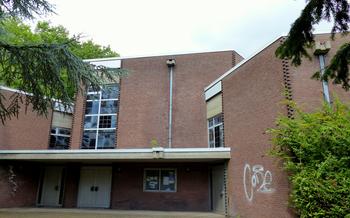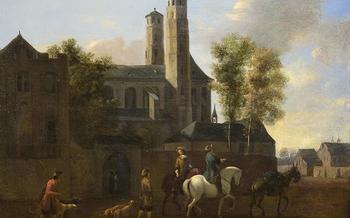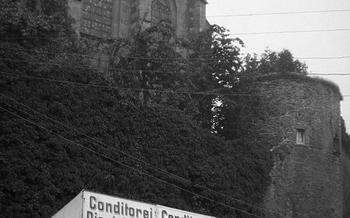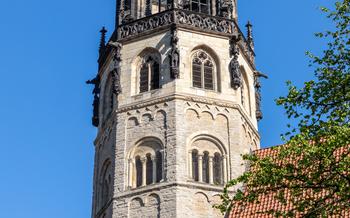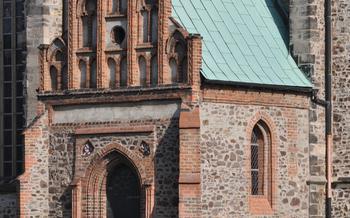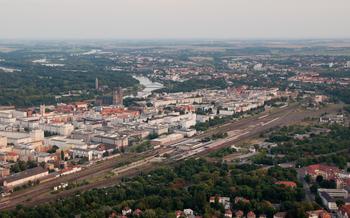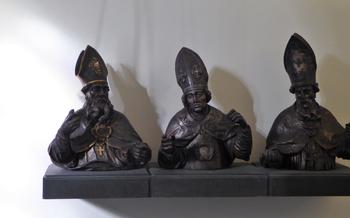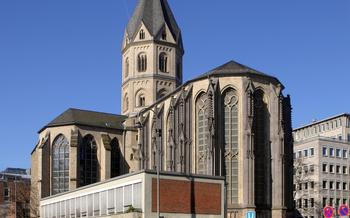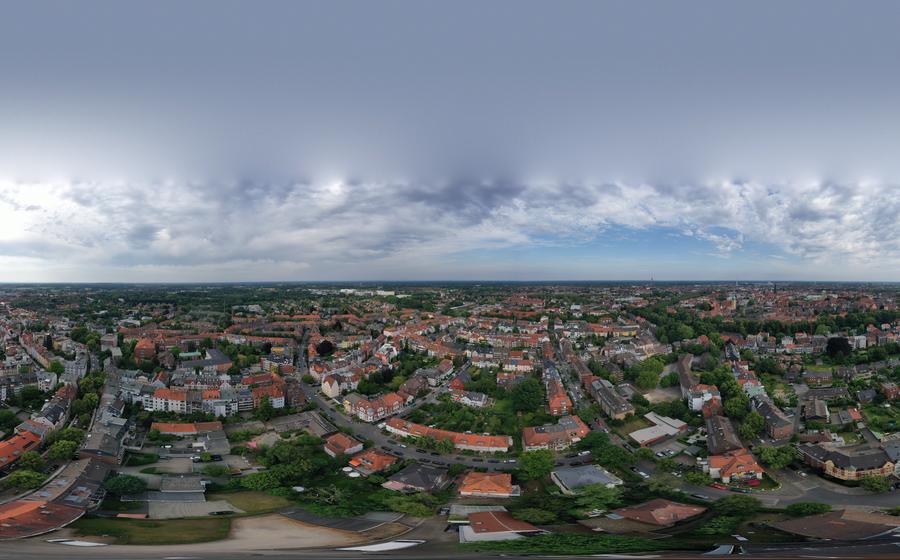
Katholische Propsteikirche St. Ludgeri
- Münster’s Landmark: Katholische Propsteikirche St. Ludgeri
- The Origins of St. Ludgeri: A Journey Through Time
- Unveiling the Architectural Masterpiece: A Blend of Romanesque and Gothic
- Exploring the Treasures Within: Art and Artifacts
- The Legacy of St. Ludger: A Man of Faith and Vision
- A Place of Worship and Pilgrimage: St. Ludgeri’s Spiritual Significance
- Witnessing History Unfold: St. Ludgeri During World War II
- The People’s Church: St. Ludgeri in the Community
- A Journey of Faith and Discovery: Guided Tours of St. Ludgeri
- The Perfect Photo Opportunity: Capturing the Beauty of St. Ludgeri
- Accessibility for All: Ensuring an Inclusive Experience
- Practical Considerations: Planning Your Visit to St. Ludgeri
Münster’s Landmark: Katholische Propsteikirche St. Ludgeri
In the heart of Münster, Germany, stands a magnificent edifice that has witnessed centuries of history and devotion - the Katholische Propsteikirche St. Ludgeri. This awe-inspiring church, fondly known as St. Ludgeri, is not just a religious landmark but also an architectural masterpiece that embodies the city's rich cultural heritage.
Brief history
The origins of St. Ludgeri can be traced back to the 8th century when St. Ludger, the patron saint of Münster, established a mission church on this site. Over the centuries, the church underwent several expansions and renovations, reflecting the changing architectural styles and the growing significance of Münster as an ecclesiastical center. The present-day church, completed in the 13th century, showcases a harmonious blend of Romanesque and Gothic elements, making it a unique and captivating sight.
Architectural highlights
St. Ludgeri's architectural grandeur is evident in its soaring spires, intricate carvings, and impressive stained glass windows. The church's exterior features a mix of Romanesque solidity and Gothic elegance, with rounded arches, buttresses, and delicate tracery. Inside, the lofty nave, supported by slender columns, creates a sense of spaciousness and awe. The intricate rib vaulting, a hallmark of Gothic architecture, adds to the visual splendor of the interior.
Significance to Münster
St. Ludgeri holds a profound significance for the city of Münster. It is not only a symbol of the city's deep-rooted Christian faith but also a reminder of its rich history and cultural heritage. The church has been a central part of Münster's religious and civic life for centuries, hosting important events, celebrations, and pilgrimages. Its presence has shaped the cityscape and the identity of the city, making it one of Münster's most iconic landmarks.
Practical information
Visiting St. Ludgeri is a must for anyone interested in history, architecture, or religion. The church is open to the public daily, with guided tours available for a deeper Einblick into its history and significance. Whether you are a devout pilgrim, an architecture enthusiast, or simply a curious traveler, St. Ludgeri offers a captivating experience that will leave a lasting impression.
The Origins of St. Ludgeri: A Journey Through Time
The roots of St. Ludgeri can be traced back to the early days of Christianity in Münster. In the 8th century, the Anglo-Saxon missionary St. Ludger arrived in the region and played a pivotal role in the Christianization of the local population. He established a small wooden church on the site where the current St. Ludgeri stands, marking the beginning of the church's rich history.
Over time, the wooden church was replaced by a stone structure, which formed the foundation of the present-day building. The church underwent several expansions and modifications throughout the centuries, reflecting the changing architectural styles and the growing importance of Münster as a religious and cultural center.
The influence of St. Ludger on the church and the city of Münster cannot be overstated. He was instrumental in spreading Christianity in the region and establishing a strong foundation for the Catholic faith. His dedication and Wirken left an indelible mark on Münster, and St. Ludgeri stands as a testament to his legacy.
Unveiling the Architectural Masterpiece: A Blend of Romanesque and Gothic
The Katholische Propsteikirche St. Ludgeri proudly showcases a captivating fusion of Romanesque and Gothic architectural styles. The Romanesque foundation establishes a sturdy framework, evident in the robust pillars and rounded arches that grace the interior. The influence of Gothic architecture manifests in the intricate details, soaring ribbed vaults, and pointed arches that lend an air of elegance and grandeur to the space.
This harmonious blend of styles creates a visually stunning effect, with the Romanesque elements providing a sense of solidity and the Gothic elements instilling a feeling of lightness and aspiration. The exterior of the church is equally captivating, featuring elaborately carved portals, intricate stonework, and graceful flying buttresses that lend support to the towering walls.
Inside, the church's spacious interior reveals a symphony of architectural elements. The massive pillars, adorned with intricate carvings, rise towards the vaulted ceiling, creating a sense of awe and reverence. The stained glass windows, with their vibrant hues and biblical scenes, cast a kaleidoscope of colors onto the interior, transforming the space into a sacred haven.
The Katholische Propsteikirche St. Ludgeri stands as a testament to the architectural prowess and artistic vision of its builders. Its unique fusion of Romanesque and Gothic styles has resulted in a masterpiece that continues to inspire and captivate visitors to this day.
Exploring the Treasures Within: Art and Artifacts
The Katholische Propsteikirche St. Ludgeri is not only renowned for its architectural brilliance but also for the wealth of art and artifacts it houses. The church's interior is adorned with a stunning altarpiece, crafted with intricate carvings and vibrant colors. It depicts scenes from the life of Christ, capturing the essence of Christianity and the church's devotion.
The stained glass windows, with their intricate designs and vibrant hues, cast a kaleidoscope of colors throughout the church. Each window narrates a biblical story, capturing moments of faith, hope, and redemption. Their artistry and craftsmanship are a testament to the skill and devotion of medieval artisans.
Impressive sculptures grace the church's interior, adding a sense of depth and spirituality to the space. These finely carved figures depict saints, angels, and biblical characters, each with their own unique story to tell. The attention to detail and the emotional expressions captured in these sculptures evoke a sense of awe and wonder.
Among the most significant artifacts in St. Ludgeri's is the skull of St. Ludger himself, enshrined in a silver reliquary. This precious relic holds immense religious and historical value, as it represents the life and legacy of the saint who played a pivotal role in the Christianization of Münster.
The Legacy of St. Ludger: A Man of Faith and Vision
St. Ludger, a renowned 8th-century missionary, played a pivotal role in the Christianization of northern Germany. Born in Friesland, he dedicated his life to spreading the word of God and establishing Christian communities throughout the region. His tireless efforts and unwavering faith earned him the title "Apostle of the Saxons."
In 777, St. Ludger founded the Ludgerikirche, the predecessor of the current Katholische Propsteikirche St. Ludgeri, in Münster. This church became the focal point of his missionary work and served as a symbol of his dedication to the Christian faith. Through his teachings and example, St. Ludger inspired countless individuals to embrace Christianity, transforming Münster into a thriving center of religious devotion.
St. Ludger's influence extended far beyond his lifetime. He established numerous monasteries and churches throughout the region, contributing to the spread of Christianity and the development of religious institutions. His unwavering commitment to his faith and his tireless work earned him the respect and admiration of both his contemporaries and future generations.
The Katholische Propsteikirche St. Ludgeri stands as a testament to the legacy of St. Ludger. The church, with its rich history and spiritual significance, continues to honor the memory of this remarkable man of faith and vision, whose Wirken left an indelible mark on the religious landscape of Münster and beyond.
A Place of Worship and Pilgrimage: St. Ludgeri’s Spiritual Significance
The Katholische Propsteikirche St. Ludgeri holds immense spiritual significance as a center of Catholic devotion in Münster. Throughout history, the church has been a destination for pilgrimages, drawing believers from near and far seeking spiritual solace and connection. The church's relics, believed to possess miraculous powers, have further contributed to its status as a sacred site. As a testament to its enduring spiritual importance, St. Ludgeri remains deeply intertwined with the religious life of Münster, serving as a place of worship, prayer, and contemplation for the faithful.
Witnessing History Unfold: St. Ludgeri During World War II
The tumultuous years of World War II left an indelible mark on the city of Münster and its beloved Katholische Propsteikirche St. Ludgeri. The city faced relentless air raids that brought devastation to its historic center, leaving countless buildings in ruins. St. Ludgeri, a prominent landmark, did not escape the wrath of the war. Its magnificent stained glass windows were shattered, its roof was damaged, and its interior bore the scars of the conflict.
Despite the extensive damage, the church's resilient spirit shone through. The community, unwavering in their faith and determination, rallied together to rebuild and restore their beloved church. With meticulous care and unwavering dedication, they embarked on a journey of reconstruction, bringing new life to the ravaged structure. The painstaking efforts paid off, and St. Ludgeri emerged from the ashes, a testament to the indomitable spirit of the Münster community.
Today, the church stands as a symbol of hope and resilience, a reminder of the transformative power of faith and unity in the face of adversity. Its restored beauty serves as a poignant tribute to the strength and perseverance of the human spirit.
The People’s Church: St. Ludgeri in the Community
St. Ludgeri Katholische Propsteikirche is not just a place of worship; it is a vital part of the Münster community, deeply woven into the city’s cultural and social fabric. The church serves as a gathering place for people from all walks of life, fostering a sense of unity and belonging among the citizens of Münster.
Throughout the year, St. Ludgeri hosts a variety of events and initiatives that bring the community together. These events range from traditional religious celebrations to concerts, exhibitions, and lectures. The church also plays a significant role in charitable work, supporting various social and humanitarian causes in Münster and beyond.
The strong bond between St. Ludgeri and the people of Münster is evident in the church’s active participation in community life. The church provides spaces for meetings, workshops, and community gatherings, creating a vibrant and inclusive environment for all. The church’s commitment to serving the community extends beyond its physical walls, as it actively engages with local organizations and initiatives to address social issues and promote the well-being of the city’s residents.
St. Ludgeri Katholische Propsteikirche is more than just a building; it is a living testament to the enduring power of faith and community. It stands as a symbol of unity, compassion, and the collective spirit of the people of Münster.
A Journey of Faith and Discovery: Guided Tours of St. Ludgeri
To delve deeper into the rich history and captivating stories of St. Ludgeri, guided tours are a must. Knowledgeable and passionate guides will lead you on an enlightening journey through the church's sacred spaces, revealing hidden corners and forgotten tales.
These tours offer a unique opportunity to gain insights into the church's architectural intricacies, the symbolism behind its artwork, and the lives of the people who have shaped its legacy. You'll learn about the church's role in Münster's religious and cultural life, and the impact it has had on the city and its people.
Guided tours are available in various languages and cater to different interests, whether you're an architecture enthusiast, a history buff, or simply someone seeking a deeper connection with this spiritual sanctuary. Advance booking is recommended to secure your spot and avoid disappointment.
Embrace the chance to embark on a journey of faith and discovery, where the past comes alive within the walls of St. Ludgeri. Let the church's stories captivate your imagination and leave you with a lasting appreciation for its enduring significance.
The Perfect Photo Opportunity: Capturing the Beauty of St. Ludgeri
The picturesque Katholische Propsteikirche St. Ludgeri offers an irresistible opportunity for photography enthusiasts. With its stunning backdrop and captivating architectural details, the church serves as a muse for both professional and amateur photographers alike.
To capture the essence of St. Ludgeri, consider positioning yourself at a slight distance, allowing the grandeur of the edifice to fill the frame. Experiment with different angles to highlight specific features, such as the intricate carvings on the facade or the towering spires that pierce the sky.
For optimal lighting conditions, plan your visit during the golden hours of sunrise or sunset. The warm hues of the setting sun cast a magical glow on the church, painting it in an ethereal light. Remember to adjust your camera settings accordingly to capture the vibrant colors and shadows.
While capturing the beauty of St. Ludgeri, it's essential to be respectful of the sacred nature of the space. Be mindful of ongoing religious services or events and avoid using flash photography that may disrupt the serenity of the environment.
With a keen eye and a touch of patience, you'll return home with a collection of stunning photographs that encapsulate the beauty and majesty of St. Ludgeri, a lasting reminder of your visit to this architectural masterpiece.
Accessibility for All: Ensuring an Inclusive Experience
Katholische Propsteikirche St. Ludgeri is committed to ensuring that everyone has the opportunity to experience its beauty and significance. The church is wheelchair accessible, with ramps and elevators providing easy access to all areas. Visitors with hearing impairments can request assistive listening devices, while those with visual impairments can take advantage of tactile maps and audio guides. Information about the church is available in multiple languages, and staff members are always happy to assist visitors with any questions or requests. The welcoming and supportive atmosphere of St. Ludgeri ensures that everyone feels comfortable and respected during their visit.
Practical Considerations: Planning Your Visit to St. Ludgeri
Before embarking on your journey to St. Ludgeri, it's essential to plan your visit to ensure a smooth and enriching experience. The church welcomes visitors with open arms, offering free admission during its opening hours, which typically span from morning to evening, providing ample time to explore its wonders. To avoid the hustle and bustle of crowds, consider visiting during the weekdays or opting for early morning or late afternoon hours.
The best time to visit Münster, and St. Ludgeri in particular, is during the summer months, when the city is bathed in warm sunshine and adorned with vibrant blooms. However, each season offers its own charm, with the festive atmosphere of Christmas adding a touch of magic to the church's ambiance.
When visiting St. Ludgeri, it's crucial to respect the sacred nature of the space. Dress modestly, avoiding attire that might be deemed inappropriate for a religious setting. Silence and reverence are highly encouraged, allowing you to immerse yourself fully in the tranquility and spirituality of the church.
With these practical considerations in mind, you're all set to embark on a memorable journey at St. Ludgeri, where history, art, and faith converge to create an unforgettable experience.
